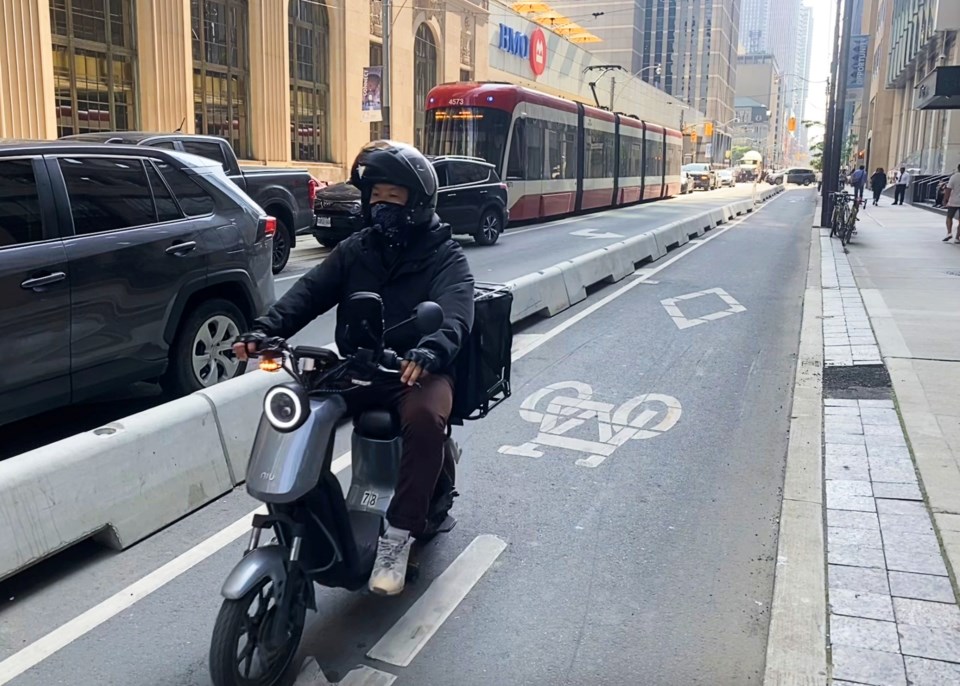What kind of vehicles are allowed to use Toronto’s bike lanes? It might seem like a straightforward question — but according to one city councillor, the answer is anything but.
Coun. Dianne Saxe (University-Rosedale), a longtime cyclist, is calling on the city to overhaul what she describes as a confusing and contradictory set of bike lane rules that are putting riders and pedestrians at risk.
On Wednesday, the city’s infrastructure and environment committee passed Saxe’s motion directing staff to develop recommendations on a new, easy-to-understand framework outlining exactly which vehicles are allowed in Toronto’s bike lanes. City council will vote on the proposal later this month.
“We’ve created a situation where there is enormous public fury about the danger created by mopeds — the crashes they’re causing, pedestrians being terrified, the lack of understanding by gig workers,” Saxe said at the committee meeting. “That situation can’t be fixed when our rules are incomprehensible.”
“We need a clear, simple, straightforward rule that a nine-year-old can explain.”
Different rules on different bike lanes
Toronto’s cycling infrastructure falls into two broad categories. Protected bike lanes, or cycle tracks, are separated from traffic with physical barriers like concrete curbs or plastic posts.
They’re commonly found on major downtown routes like Bloor Street, Richmond Street, and University Avenue.
Painted bike lanes, by contrast, use only a strip of paint to separate bikes from cars and appear on roads such as Shaw Street, Argyle Street and Winona Drive.
Both types of lanes are marked with a diamond symbol, indicating they’re reserved for cyclists. But here’s where things get complicated: different rules apply depending on the type of lane.
Currently, pedal-powered bikes, pedal-assist e-bikes and electric cargo bikes with front baskets are allowed in both painted lanes and cycle tracks.
But throttle-based e-bikes — ones that don’t require pedalling — are only permitted in painted bike lanes. Mopeds, e-scooters and motorcycles that can exceed 32 kilometres per hour aren’t allowed in either type of bike lane, though enforcement is limited.
Saxe argues that many riders don’t understand or follow these distinctions, leading to dangerous interactions on Toronto’s streets. She says mopeds in particular “absolutely don’t belong” in bike lanes.
But some are concerned new rules — and stronger enforcement — could come at a cost.
Oda Al-Anizi, a wheelchair user, told the committee he worries tougher enforcement could make the city less accessible. He uses an e-bike-style attachment that turns his wheelchair into a three-wheeled vehicle that tops out at 30 kilometres per hour — and gets him around the city much faster.
“Last year, I clocked over 4,000 kilometres because it became my main method of transportation,” he said. “But it’s my understanding that I’m not legally allowed to use the bike lanes because I have a three-wheel vehicle.”
Michael Longfield, executive director of the advocacy group Cycle Toronto, supports clarifying the rules but warned against over-policing.
“It would be a colossal waste of limited Toronto police resources to focus enforcement here when it’s primarily motor vehicles that are responsible for deaths and serious injuries on our roads,” he said.
He also called on provincial and federal governments to step up regulation of new electric vehicles, saying cities can’t keep pace with the rapidly evolving micromobility industry on their own.
If passed by council, the motion directs city staff to report back with recommendations on new, unified bike lane regulations by early 2026.




